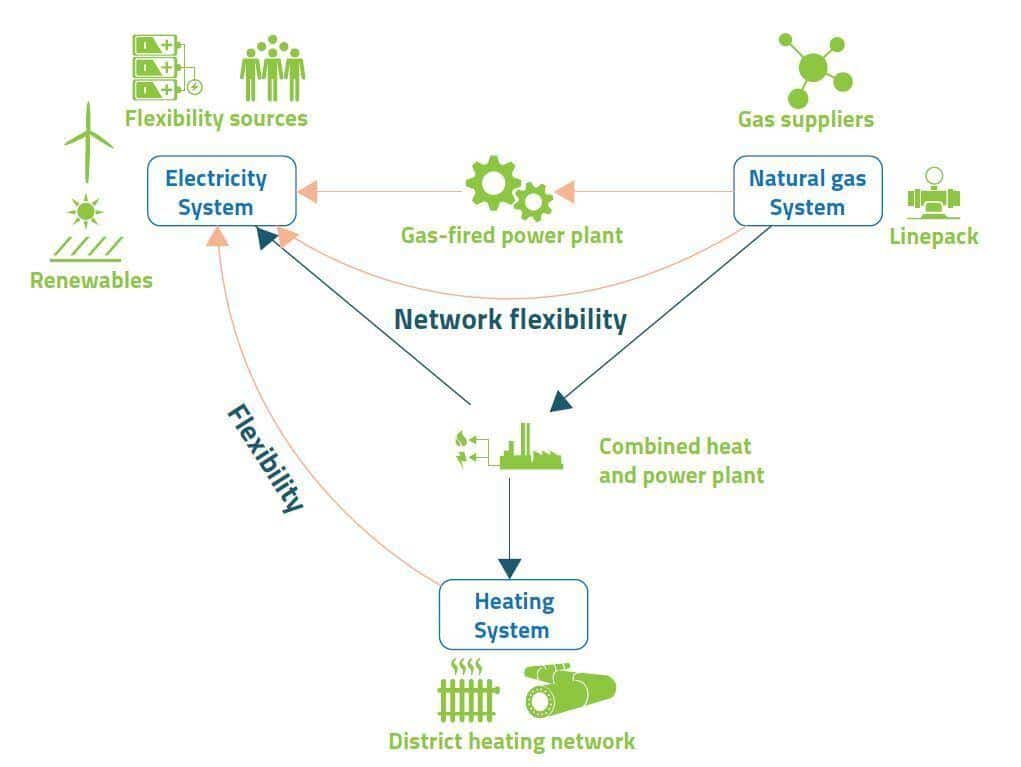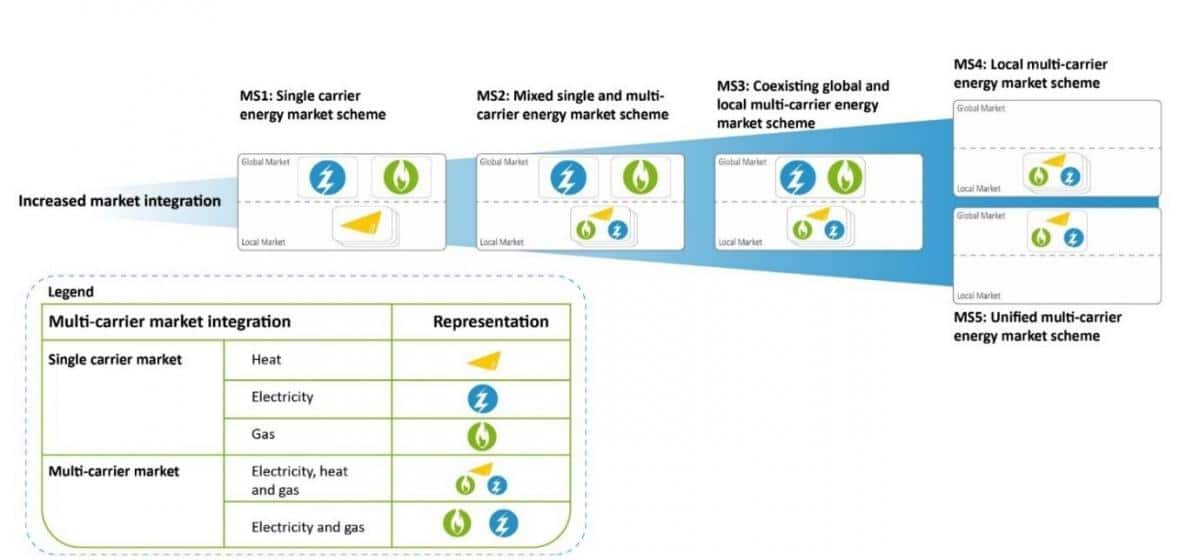Expert Talk: Smart energy system integration: Towards market-enabled clean and coordinated energy sectors
Energy system integration means coordinated planning and market-based operation of different energy systems “as a whole”. Such a holistic energy system approach, inclusive of all technologies, is needed for a cost-efficient energy transition, to guarantee the resilience and security of future energy systems. To ensure a coordinated operation of different energy systems, it is necessary to take into account the economic aspects of different energy vectors (gas, heat, electricity, etc.). Currently, the market structure of these different energy vectors varies significantly. To unlock the potential of energy system integration on a global level, sound market-based coordination structures are lacking, although we already see a trend towards energy system integration on a local level, e.g. with the advent of local energy communities.
Written by Ana Virag, Kris Kessels, and Anubhav Ratha, all EnergyVille/VITO.
Previously, we already discussed the different trends in electricity systems and markets. In the expert talk on the evolution of system operation and impact on market design, it was highlighted how higher renewable energy penetration and electrification pose challenges to the current electricity system operation and market design. A more recent expert talk focused on energy communities and their role in the energy transition. This month, we will address the importance and challenges of adjusting the energy markets to facilitate energy system integration and hence, the energy transition.
What is energy system integration?
Energy system integration is the coordinated planning and market-based operation of different energy systems “as a whole”; across multiple energy carriers, infrastructures, and consumption sectors [1] (e.g., gas and electricity, but also heat and electricity, etc.). In recent years, energy system integration received much political [1], [2], and also scientific attention [3]. Energy system integration is perceived as key for the European energy transition according to the Green Deal [2].
An integrated energy system with technology diversity and neutrality not only provides a cost-efficient clean energy transition but also guarantees the resilience and security of the future energy systems by leveraging the synergies and flexibility that exist among the various energy systems, see e.g. Figure 1.
One of the six pillars of the energy system integration strategy identified by European Commission in [1] is “Making energy markets fit for decarbonisation and distributed resources”, accompanied by the key action to “promote a level-playing field across all energy carriers”.
Towards market-based energy system integration
To ensure a coordinated operation of different energy systems, it is necessary to take into account the economic aspects of governing different energy vectors. Currently, the market structure of different energy vectors varies significantly. The fragmented way in which the different energy vectors are operated is one of the key obstacles to smart energy system integration.
The markets of different energy systems, e.g., heat, gas and electricity, are currently not harmonised, or even coordinated in any structured way. The market designs for different energy carriers should be, as a minimum, more coordinated and possibly completely redesigned to enable market-based energy system integration. Existence of separate different designs e.g. for electricity and gas markets, with different regulation, market concepts and market roles, and the lack of flexible heat markets currently represent one of the major barriers for energy system integration.

Even worse, there are market barriers to electrification or flexibility provision to the electricity system from other sectors. For instance, high network tariffs, taxes and levies imposed on the electricity prices pose a barrier for investments in electricity-based alternatives for industrial processes, heating or transport, thus preventing faster electrification of other sectors. They also make business cases for conversion technologies such as power-to-gas not profitable. High network tariffs, taxes and levies imposed on the electricity prices also make the energy component of the total electricity price relatively small for the end consumer, so providing flexibility is often not sufficiently economically attractive. As another example, in some cases, the consumer or a group of industrial consumers on an industrial site is charged for its peak electricity offtake. The provision of electricity flexibility services might easily violate such peak constraints, which further decreases the flexibility value for the flexibility provider. As a final example, insufficient coordination between network operators also appears to be a barrier to flexibility provision, e.g. in case a flexibility provider is located in a congested area. Proper coordination is needed between distribution system operators and transmission system operators in the electricity system, and also between electricity, gas and heating/cooling network operators.
A market design in support of the energy system integration should unlock the full CO2 savings potential in the most cost-efficient way from each of the integrated energy systems, taking into account their physical and operational characteristics.
Different market-based coordination structures are possible: from (i) keeping the separated market designs, with minor adjustments, such as e.g .aligning the respective timings of markets (e.g. the moments in the day until it is possible to adapt market participants’ supply or demand positions, the so-called gate closure times) to e.g. (ii) the introduction of financial instruments across different energy systems to (iii) explicit market integration in terms of common market-clearing of different energy systems.
Initiatives
Figure 1 illustrates five possible market-based coordination structures for operating integrated energy systems, with geographical considerations [4]. The market-based coordination structures are developed for electricity, gas, and heating systems, but are ready to be generalized for other energy systems as well. They are originally developed for the ahead energy markets, and not for flexibility trading.

In market structures MS1: Single carrier energy market, there is no formal link between markets in the product definition and/or the market clearing process. Gas and electricity markets are considered as global markets and heat markets are local. Market scheme MS2: Mixed single and multi-carrier energy market scheme is an extension of the first market scheme, where market integration is considered at the local level (e.g., there is market-based coordination of different energy systems within the energy communities or local energy markets). At the global level, there are only single carrier markets for electricity and gas.
The third market structure, MS3: Coexisting global and local multi-carrier energy market, applies market integration of different energy carriers both at the local and global level. Gas and electricity markets at the global level are also integrated into a common multi-carrier market. MS4: Local multi-carrier energy market scheme is considered to be the most disruptive, as there are only local multi-carrier markets (for heat, gas and electricity). Finally, in the fifth market structure (MS5: Unified multi-carrier energy market scheme), the energy system markets are fully integrated and operated by a single market operator.
The last market structure (MS5) represents the benchmark regarding market efficiency as it will result in the highest social welfare value. The first market structure (MS1) resembles most to the current one as implemented in Europe.
As indicated in the figure, energy system integration can take place on different geographical levels: global (e.g., national or supranational), or local (district, city, region). The coordination degree could vary depending not only on the geographical but also on the market timeframe. For instance, for long-term perspective trading, there could be relatively low coordination among the energy systems, while increasing levels of coordination could be considered towards for instance day-ahead trading.
Conclusion
Integration of different energy carrier markets is challenging because of the physical and economic dependencies between the different energy carriers at different points in time. Such dependencies are currently not considered in the market design, but it is crucial to adequately account for them to achieve the full potential of energy system integration.
Whereas there is much to be gained by market-based coordination of energy systems, achieving it will require all the energy systems to adjust the current governing paradigms and converge towards market-based coordination of different energy systems. It will require changes in roles and their interactions, introduction of new roles, and smart, forward-looking regulation.
At VITO/EnergyVille, we have a strong track record in energy-market design, market modelling and business model evaluation for cross-sector integration and research innovative market concepts and solutions for such integration. Additionally, we have up-to-date knowledge of the regulatory context of the different sectors. We focus on different system levels, from global markets (spanning continents) to local markets (for instance at the level of an energy community comprising different energy vectors), and support various decision-makers (regulators, system operators, governments,…) in accelerating energy transition by innovating the current market design and making recommendations to overcome regulatory bottlenecks. Want to know more? Do not hesitate to get in touch with one of the authors.
Key takeaways
- Energy system integration is key to reach decarbonization goals.
- There is value in energy system integration, in terms of improved cost-efficiency and CO2 savings enabled by harnessing the synergies and flexibility among the energy systems, but there are also many technical, economic, societal, regulatory and practical open questions on the correct market-based energy system coordination.
- In research, development, and demonstration activities, more emphasis should be given to the economic and regulatory aspects of the proposed operational solutions for energy sector integration, moving towards a more harmonized market-based energy system operation.
- Energy system integration could already be achieved on a local level (e.g. within an energy community).
Authors
- Ana Virag is a research domain leader for energy markets at VITO/EnergyVille. She focuses on electricity market design topics and market coordination for energy systems integration.
- Kris Kessels is a senior researcher within the energy markets team at VITO/EnergyVille. She mainly focuses on market design in a multi-energy context and for system operators.
- Anubhav Ratha is a doctoral student at the Technical University of Denmark (DTU) and VITO working on the topic of market design for future integrated energy systems.
References
- [1] European Commission, “Powering a climate-neutral economy: An EU Strategy for Energy System Integration”, COM(2020) 299, URL: https://ec.europa.eu/energy/sites/ener/files/energy_system_integration_…, last accessed: Nov 2020
- [2] European Commission, “The European Green Deal, COM(2019) 640”, URL https://eur-lex.europa.eu/resource.html?uri=cellar:b828d165-1c22-11ea-8… last accessed Nov 2020
- [3] M. O’Malley, B. Kroposki, B. Hannegan, H. Madsen, M. Andersson, W. D’haeseleer, M. F. McGranaghan, C. Dent, G. Strbac, S. Baskaran, and M. Rinker, “Energy systems integration: Defining and describing the value proposition,” Jun. 2016, National Renewable Energy Laboratory, Report NREL/TP-5D00-66616
- [4] K. Kessels, S.S. Torbaghan, A. Virag, H. Le Cadre, G. Leclercq, P. Sels, M. Madani, “Innovative Market Schemes for Integrated Multi-energy Systems,” 2019 16th International Conference on the European Energy Market (EEM), Ljubljana, Slovenia, 2019, pp. 1-6, DOI: 10.1109/EEM.2019.8916382.


